Study on Local Fiscal Policies and Practices Addressing Poverty Issues of Local Government Units in Lanao del Norte
There are about 77 million Filipinos suffering from poverty today and this number is growing by 2.05% annually (notes on Poverty in the Philippines, 2002). This means that some 1.5 million Filipinos are born every year from poor families.
To this effect, the United Nation General Assembly ended the Millennium Summit by adopting a set of Millennium Development Goals (MDGs) in order to eradicate extreme poverty and hunger. As a response, Asian Development Bank (ADB) embarked the so-called Poverty Reduction Strategy as embedded in the Long Term Strategic Framework. It identified three fundamental pillars of poverty reduction, namely, a) pro-poor sustainable economic growth, b) inclusive social development, c) good governance. It also included cross-cutting priorities of environmental sustainability, gender equity, private sector development, and regional cooperation. In this connection, the present administration launched its development agenda to address poverty and unemployment. Out of this, the Philippines ratified the Medium Term Philippine Development Plan (MTPDP) which incorporated the MDGs and the ten-point agenda of the administration. This development plan was conceptualized, taking into account not only income but its impact in terms of human deprivation and quality of life.










